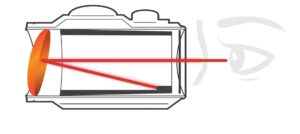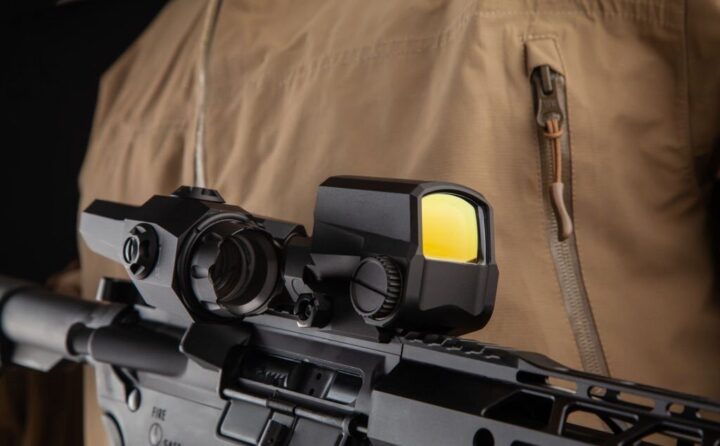Red dot vs reflex sight
Two of the most common types of sights used on firearms are red dot sights and the reflex sight. Both types of sights use an LED or a similar technology to project a dot or reticle onto a lens, allowing the shooter to easily aim at their target.
However, despite their similarities, there are some significant differences between red dot sights and reflex sights that make each type better suited for specific applications.
The Red Dot Sight
Well, a red dot is a generalized term that refers to anything that works by use of this LED dot, so it’s safe to say that reflex sights are red dots as well. The LED does not have to be red; it can be any color, the most common being red and green.
It works by illuminating a dot on a glass lens that is placed in front of the LED, the lens has a reflective material that reflects the light back to the shooter’s eye. when a shooter looks through the lens the LED dot appears like it’s superimposed on the targets, and helps with aiming

However, the red dot differs in appearance from the reflex sight.
On the mention of the red dot sight the picture that comes to mind is a scope with an overall shorter length.
The red dot has a complete body enclosing the glass lens, and this brings with it certain advantages
Advantage of a red dot sight
- More durable than the reflex sight because of the enclosed lens that gives it the ability to withstand bumps, recoil, and knocks.
- Better visibility in bright light- the body enclosing the lens acts like some sort of sunshade that minimizes the sun’s glare.
- The red dot has a more precise aiming courtesy of a finer reticle
Reflex sight

A reflex sight works more in the same way as a red dot, however, rather than using a single plane to reflect the LED reticle it uses a slightly curved reflective lens. Next, instead of projecting the reticle onto the shooter’s eye, the reticle is projected into the shooter’s field of view
The curved reflective lens makes it easy for the shooter to see the reticle from various angles but results in a coarser appearance of the reticle.
Reflex sights come in two distinct designs these are;
Exposed/open reflex– this has a single lens positioned in front of the sight resembling a heads-up display. This type of reflex sight has a smaller body covering the lens and is more likely to be damaged on heavy impact.
Tube reflex– This one resembles a traditional scope, or a red dot, and has the lens enclosed inside a tube body. It’s more durable but doesn’t give the shooter great situation awareness like the open reflex sight.
Difference Between Red Dot Vs Reflex Sight
These are some of the differences that can help a shooter make a decision between a red dot and a reflex sight.
Reticle
A red dot sight typically uses a dot for aiming, whereas a reflex sight can have a reticle with a variety of designs depending on the model.
Furthermore, when aiming at a target, each of these scopes is used differently. All that is required when using a reflex sight is to align the reticle with the target. In contrast, a red dot must be floated on a target, which means it must be placed directly on top of the target.
Well, it’s very easy to adapt to a particular way of aiming at a target, and the choice here will mostly depend on personal preference
Field of view
A wider field of view is advantageous to a shooter because it aids in target tracking and raises awareness of the surroundings. In terms of field of view, reflex sight has a slight advantage.
This is due to the smaller body of the reflex sight, particularly the open reflex, which reduces the blind spot and allows the shooter to use both eyes when aiming.
Durability
Of course, durability had to be a consideration, especially when comparing the open reflex to the red dot. When both of these are used in tactical applications, the red dot may be preferred if durability is a concern. This is due to the enclosed casing protecting the lens from damage.
Parallax
The reflex sight has less parallax because it uses a curved reflective lens to reflect the reticle into the shooter’s field of view. The accuracy of the red dot sight varies when the position of the target or the shooter’s head changes, even when the gun is held perfectly still.
Battery life
The red dot illuminates the reflective lens with a more efficient LED, and the single plane consumes less power. As a result, some people may regard the red dot as more reliable, particularly if they are spending an extended period of time in the field.
Price
In general, the price of red dots is slightly higher than that of reflex sights. Although this varies depending on the model, reflex sights are typically simpler in design. The red dot employs advanced technologies, which explains why it provides a finer reticle.
Let’s look at some of the best and most popular red dot and reflex sights available on the market…
Best Red Dot Sights
- Sig Sauer Romeo5 1x20mm sight
- Bushnell trophy TRS-25 red dot sight
- Vortex Optics SPARC Gen II red dot Sight
Best Reflex Sights
- Burris fast fire III
- Bushnell RXS100 Reflex Sight
- HOLOSUN HS507K-X2 reflex Sight
- Vortex Optics Razor reflex
CONCLUSION
There will always be a contention of red dot vs reflex sight, but the best will depend on personal preference. This review has highlighted the main differences between these two types of sight and it’s now the responsibility of the buyer to decide what they desire in their sight, and what they can compromise.
The best way to determine what you would prefer would also be to test both of these and see which one is more effective and comfortable for you.
Related
